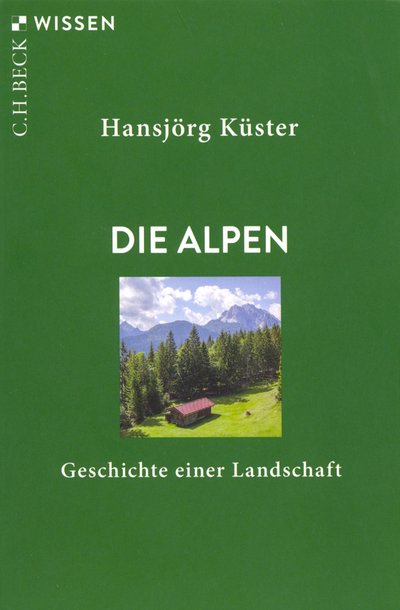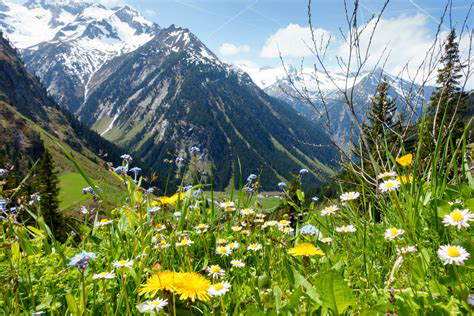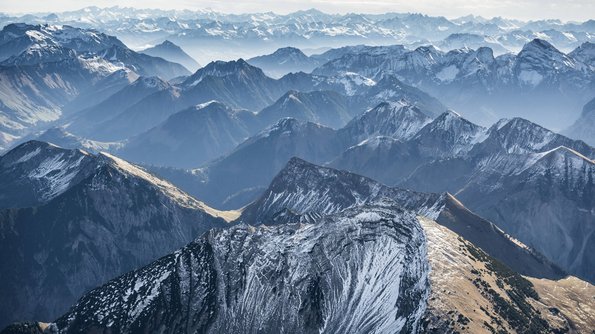The Alps, history of a landscape
A book review by Renate Dünki
Recently I was given a book, a small booklet out of the Beck-series “Knowledge” by Hansjörg Küster. “Die Alpen. Geschichte einer Landschaft.” (The Alps, History of a Landscape). When opening it, I quickly realised the broadness of topics, ranging from geology over vegetation, first settlements and finally the formation of the alpine landscape since the Middle Ages. There is a particular chapter each, for Switzerland, its folk musik, the opening of the mountains for tourism and the present.
Küster is plant ecologist at the University of Hannover. He published on other landscapes as well.
The author starts his story with a glance out of his window at the beginning of his first alpine travels. “I opened the window and there was a wonderful landscape spread out before me.” There were many personal travel impressions enlarging this first glance and enhancing his conviction that the character of this landscape is molded by nature as well as by culture and must definitely not be understood merely as an object of nature conservancy, as wilderness. Küster wishes to trigger a more complex understanding of the Alps and its history and he certainly succeedd in this endeavour with this little book that is written intelligently and well understandably also for a layperson. A map of the Alp’s mountain range from East to West is included and the texts are always illustrated by pictures, but no glossy ones.
Never before have I read the history of the Earth – starting 200 million years ago until this day – in such an appealing way. Also the history of man’s steps fom first questions about nature up to secured knowledge are included.
Ice Times and vegetation
In the chapter “Vegetation” the descriptions about the impact of the ice times are particularly enlightening. The Alps behaved like a barrier against Europe’s vegetation. “In every Ice Time all the trees north of the Alps died back” (p. 38) In other continents with a similar vegetation the mountain ranges did not form an insurmountable wall but the trees could reoccupy their former positions after the ending of the Ice Times. That is why in other continents there is a much greater biodiversity than is the case in Europe. The vegetation became scarcer and scarcer after each Ice Time period. The result is that today in many parts of Europe there is only one tree species dominating. These forests are particularly susceptible tow pest infestation, which is a consequence of their vegetation history and topography.
The historian’s view on the Alps’ settlements reveals the following: From the early colonisation by hominids up to the period after the Ace Time, the pre-historical pile dwellings, the “Ötzi” (the Iceman), the Alpine farming, which may have given the mountain range its name, up to the network of roads built by the Romans.
The next chapter deals with the settling during the Middle Ages, with the diverse types of houses evolving in accordance with the different weather conditions, going on with the laying out of gardens, meadows and fields and the multiple forms of agriculture.
Switzerland – a mountainous state
Whereas large parts of this alpine landscapes belonged to different state formations and their economic regions, Switzerland developed as a mountainous state of which only small parts are located outside the mountain region. Again, the author succeeds in picturing Switzerland’s particular economy comprehensively and in an enthralling manner. The development of natural science by Conrad Gessner in the 16th and by Jakob Scheuzer in the 17th century with his “138 questions about the nature of Switzerland” (1699) for instance, is very informative for the reader. In the 18th century, Albrecht von Haller described the Alps’ altitudinal belt with its characteristic vegetation for the first time. This work became the basis for the research of Alexander von Humboldt, which was paid tribute to in 2019, before the lockdown, in great exhibitions in Berlin. So, many an impulse for the emerging natural sciences took its starting point in Switzerland.
The author also grants a survey on art, music and literature, as well as the development and significance of tourism.
And what about today? “The objective can never be only one goal, e.g. the protection of one animal or plant species, but there are many very diverse phenomena that have to be observed simultaneously.” To appreciate and preserve this “extraordinary and beautiful landscape of worldwide significance with all its treasures of nature, culture and ideas” must be the goal as well in future times.
The richness of this small booklet on the history of the alpine landscape could only be outlined here. It is a pleasure to get to know the ingenuities of this remarkable plant ecologist and obtain a more precise view on the Alps, the first high mountain that was successfully opened and developed. •


